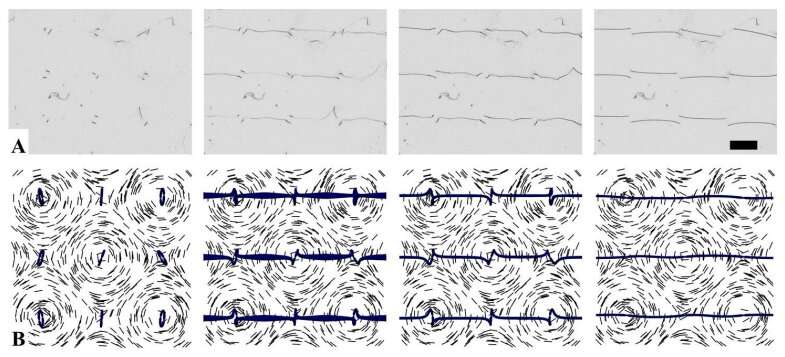This article has been reviewed according to Science X's editorial process and policies. Editors have highlighted the following attributes while ensuring the content's credibility:
fact-checked
peer-reviewed publication
proofread
Scientists realize light-driven programmable colloidal self-assembly

Prof. Peng Chenhui's team from the School of Physics, University of Science and Technology of China (USTC), realized the collective transfer and reconfigurable self-assembly of colloidal particles by combining the light-driven molecular motors with liquid crystal (LC) molecules in the nematic phase whose orientations are programmed with topological patterns and disclination networks.
The work was published in Proceedings of the National Academy of Sciences on April 11. Through light irradiation, the cooperative reorganizations of nanomotors induce collective dynamics of the disclination networks. The morphology changes of the disclination lines are utilized to transport and reconfigure the colloidal assemblies in translational, rotational, and programmable fashions. This work opens the door for future applications in micromachines and smart materials.
Nanomotors in nature have inspired scientists to design synthetic molecular motors to drive the motion of microscale objects by cooperative action. Light-driven molecular motors have been synthesized, but using their cooperative reorganization to control the collective transport of colloids and to realize the reconfiguration of colloidal assembly remains a challenge.
In this work, topological vortices are imprinted in the monolayers of azobenzene molecules which further interface with nematic liquid crystals (LCs). The light-driven cooperative reorientations of the azobenzene molecules induce the collective motion of LC molecules and thus the spatiotemporal evolutions of the nematic disclination networks which are defined by the controlled patterns of vortices. Continuum simulations provide physical insight into the morphology change of the disclination networks.
When microcolloids are dispersed in the LC medium, the colloidal assembly is not only transported and reconfigured by the collective change of the disclination lines but also controlled by the elastic energy landscape defined by the predesigned orientational patterns. The collective transport and reconfiguration of colloidal assemblies can also be programmed by manipulating the irradiated polarization. This work provides opportunities to design programmable colloidal machines and smart composite materials.
In the study, the team also elucidated how the pre-designed topological defects control the motion mechanism of colloidal particles on the disclination lines, which is determined by the elastic properties of the local pre-designed unfolding and bending deformation of liquid crystals. Thus, the physical mechanism of this light-driven programmable colloidal self-assembly lies in the cooperative reorganization of the nanoscale molecular machines by light, and the interaction of the molecular machines with the liquid crystal molecules is used to control the change of the nanoscale liquid crystal molecular orientation.
Due to the long-range ordered nature of the liquid crystal molecules, a change in the orientation of the surface macroscale liquid crystal molecules is triggered. This macroscopic change further drives the change of liquid crystal microstructure inside the sample through surface anchoring, thus enabling macroscopic-scale reconfiguration toward disclination networks and colloidal self-assembly.
More information: Jiang, Jinghua et al, Collective transport and reconfigurable assembly of nematic colloids by light-driven cooperative molecular reorientations, Proceedings of the National Academy of Sciences (2023). DOI: 10.1073/pnas.2221718120.
Journal information: Proceedings of the National Academy of Sciences
Provided by University of Science and Technology of China





















